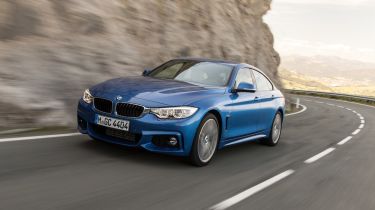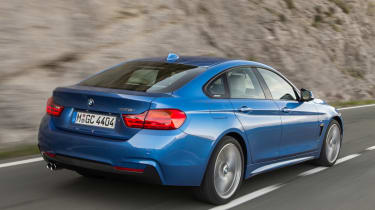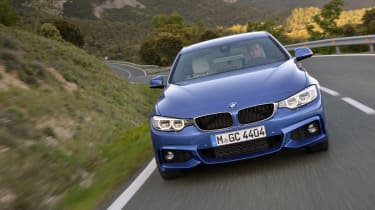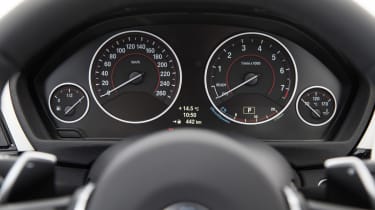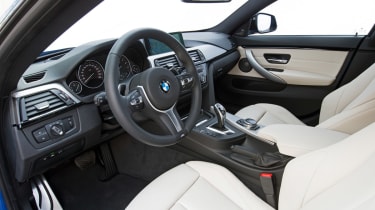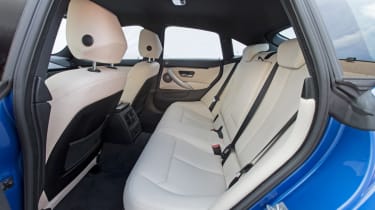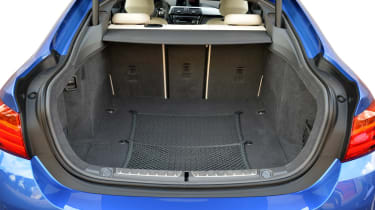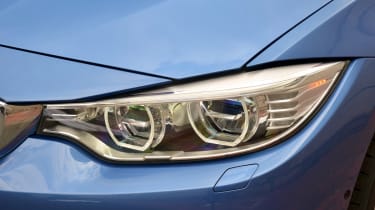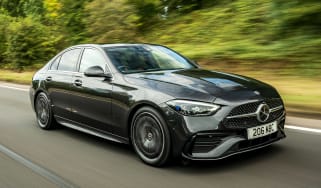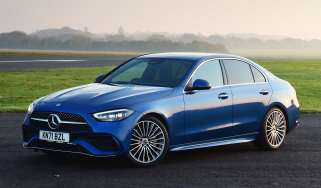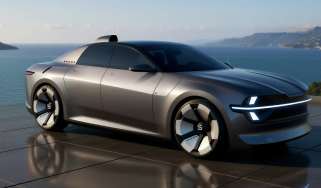BMW 4 Series Gran Coupe (2013-2021) review
The BMW 4 Series Gran Coupe blends the 4 Series Coupe’s sharp design with some of the 3 Series’ practicality

Just so you know, this is an older review of the 2013-2021 BMW 4 Series Gran Coupe. If you are interested in information about the latest BMW 4 Series Gran Coupe, or news of upcoming BMW models, please follow the links provided.
BMW has pretty much perfected the art of creating cars that appeal not just to large groups of buyers – with the big-selling 3 Series and 5 Series executive saloon ranges, as well as the hugely popular X1, X3 and X5 SUVs – but also much narrower, more niche markets.
Customers seeking something different wearing a blue and white propeller badge can take their pick from the likes of the four-door 6 Series Gran Coupe, the 2 Series Active Tourer people carrier and the X6 coupe-SUV, for example.
Crucially, these more niche models sell in large enough numbers for BMW bosses to justify the extra development costs. Indeed, it can sometimes be a little difficult to tell whether a new model from the brand is the result of customer demand, or whether customer demand is created by the introduction of a desirable new BMW.
The 4 Series Gran Coupe is a perfect example of this. Look at it logically, and there shouldn’t be a market for this car – as it’s effectively a four-door version of the coupe version of the 3 Series saloon. If you want a low-slung coupe, so logic would have you believe, you buy a 4 Series two-door. If you want a practical family car, you buy a standard 3 Series saloon – or maybe a 3 Series Touring estate or a long-wheelbase 3 Series GT hatchback.
Used - available now

2016 BMW
4 Series
107,000 milesAutomaticDiesel2.0L
Cash £8,295
2026 BMW
4 Series
24,296 milesAutomaticPetrol2.0L
Cash £29,100
2021 BMW
4 Series
49,942 milesAutomaticPetrol2.0L
Cash £25,342
2026 BMW
4 Series
19,927 milesAutomaticPetrol2.0L
Cash £26,755Yet BMW designed the 4 Series Gran Coupe for drivers who want to combine the practicality of the 3 Series and the styling and kerb appeal of the 4 Series – and it seems there are plenty of them out there.
This car is still a coupe, but with four frameless doors and a reasonably practical boot under a big hatchback lid. It’s low enough to be desirable, long enough to be versatile for day-to-day use and still every inch a proper BMW, with all of the driving enjoyment and quality that implies.
The 4 Series Gran Coupe also carries a sizeable price premium over the regular 3 Series saloon, yet brings no step up in boot size. Instead, it scores on style and image; and it’s difficult to ignore its charms.
The BMW 4 Series first arrived as a coupe version of the 3 Series saloon back in 2013, before the manufacturer sliced the roof off to create the 4 Series Convertible a year later. The number '4' was used to denote the sportier versions of the more sensible and more practical 3 Series models – despite the 3 moniker's near 40-year history. Shortly after the 4 Series Coupe and Covertible, BMW released the Gran Coupe – a sleek four-door model to rival the Audi A5 Sportback.
Some potential buyers will be left scratching their heads, wondering how BMW can justify charging a premium of around £6,000 for the Gran Coupe over the more versatile 3 Series saloon. Others will get it straight away, and see that this car is more about style and practicality in equal measure. Either way, BMW appears to be on to a winner by offering such a wide choice in its range.
Engines, performance and drive
On the road, the 4 Series Gran Coupe feels almost exactly the same as the two-door 4 Series Coupe. You get the same weighty but responsive steering, the same strong body control and slightly firm ride, and the same sense of being truly engaged with the driving experience.
The extra doors, bigger boot and slightly longer body bring a weight penalty of around 50kg over the two-door 4 Series, but through a series of corners you wouldn’t know it – the Gran Coupe shrugs this off and delivers the handling agility we’ve come to expect from the brand. Most models are rear-wheel drive, although buyers can specify BMW’s xDrive four-wheel-drive system on the 4 Series Gran Coupe and benefit from even stronger acceleration and the reassurance of all-weather traction.
Engines
Many drivers will find it difficult to look beyond the 420d Gran Coupe with its incredible combination of 187bhp punch and 106g/km CO2 emissions. The only letdown with this model is its noise suppression – BMW’s latest four-cylinder diesels are simply too vocal, and are now being left behind by excellent engines such as the Audi 2.0-litre TDI and Volvo D4 in terms of refinement.
Still, once the 420d has warmed up, it becomes a lot quieter, plus if you can put up with the noise, the car has performance to spare – it sprints from 0-62mph in only 7.3 seconds. There are also deep reserves of torque available, with 400Nm from 1,750rpm, so the 420d is effortless to drive whether you’re pounding the motorway network or tackling a twisty mountain road.
For a seriously quick 4 Series, go for one of the bigger 3.0-litre six-cylinder diesels. The 254bhp 430d promises 0-62mph in 5.6 seconds, though adding the grippier xDrive all-wheel drive system shaves off another three-tenths of a second. The 309bhp 435d (only available with xDrive) claims a time of 4.8 seconds, yet neither brings a particularly heavy penalty in terms of fuel economy.
In 2016, BMW replaced the twin-turbocharged straight-six 435i petrol with the more powerful 440i. This is a wonderful engine – silky smooth and bursting with power – but it will cost you a fortune to run. Potentially a better bet for petrol fans is the 2.0-litre four-cylinder turbo in the 430i (previously 428i). It provides much of the 440i’s performance hit without punishing you quite so hard at the pumps. There's currently no M4 Gran Coupe or super-frugal plug-in hybrid like you'll find in the 3 Series.
MPG, CO2 and Running Costs
There’s a mismatch between the premium looks of the 4 Series Gran Coupe and its surprisingly affordable running costs. BMW’s 2.0-litre diesel engine, in all its various guises, has an uncanny ability to use less fuel than you think it’s going to. Owners should easily be able to achieve mid-fifties mpg, even with lots of town driving, and there’s genuine potential to break the 60mpg barrier on longer journeys. Driven gently, a 420d Gran Coupe should cost you no more in fuel than a family hatchback.
And you won’t pay much in road tax, either. Fitted with the optional eight-speed automatic gearbox, the 420d emits a remarkable 106g/km of CO2, which means a year’s VED will set you back only £20. Even if you stick with the standard manual box, emissions only rise to 111g/km, but that still means just £30 for a year’s tax.
Obviously, it’s a different picture if you buy a petrol model, with a 420i costing £145 a year in VED. But its fuel consumption shouldn’t be too horrific – reckon on getting low-forties mpg out of it, or mid-thirties from the racier 430i.
Owners who are focused on maximising their efficiency can use the Drive Performance Control system to help. This offers a choice of modes that adjusts the steering, transmission and suspension, and if you leave it in the Eco Pro setting, the car will use the minimum amount of fuel. But realistically, you’re not going to do an awful lot worse in Comfort mode.
Insurance Groups
The 4 Series Gran Coupe isn’t going to be the cheapest car to insure, with a full-fat 435d xDrive being all the way up in Group 41. Our favourite model, the 420d M Sport, sits a bit lower, in Group 30.
Depreciation
A projected 49.4 per cent retained value after three years is pretty much as good as it gets in the motoring world, and puts the 4 Series Gran Coupe on a par with its primary rival, the Audi A5 Sportback. While the appeal of the Gran Coupe may be a little narrower than the conventional 4 Series Coupe, the fact that there’s fewer of them out there adds a touch to its rarity value.
Interior, design and technology
You know what you’re going to get when you climb inside a 4 Series Gran Coupe, and it’s a generic BMW cabin design. Now, that’s not necessarily a bad thing: the driving position is wonderfully low-slung (although it’s also noticeably offset), plus there are large, clear and expensive-looking instruments and the quality of the finish is very impressive.
The problem comes with that predictability – the sense that you could just be sitting in a standard 3 Series or even a 1 Series hatchback. The 4 Series Gran Coupe doesn’t really stand out or feel particularly special.
Plus, although this car is reasonably well equipped as standard, you will have to splash out on optional extras to bring it towards a level that matches its rivals in this class. The basic specification feels a bit too stripped out and bare.
Anyone who’s looked inside an i3 electric car or hybrid i8 supercar at their local dealer will know BMW is capable of much more exciting layouts than this. The company has also been left behind in recent times by Mercedes, with models like the latest C-Class crowning BMW’s arch rival as the king of premium car interior design.
That’s not to say the 4 Series Gran Coupe is completely flawed inside, though; there is much to like here. The big colour screen in the centre of the dashboard still looks classy, while the frameless doors make getting in and out of the car more of an event than it is in the 3 Series, for example.
Sat-Nav, stereo and infotainment
Tech has always been a BMW watchword, and the 4 Series Gran Coupe doesn’t disappoint. Basic SE models come with Bluetooth, DAB and a 6.5-inch infotainment screen with the BMW Business navigation system that includes traffic alerts.
Upgrade to Luxury spec and you get the BMW Professional media package with a larger display and a touch-sensitive iDrive rotary controller. You can also spec it with BMW Connected services, which allow a smooth handover between your smartphone and the car’s on-board systems, as well as music streaming. Plus, if the car is involved in an accident, it automatically contacts the emergency services.
There’s even an option of iConnectedDrive, which accesses the sat-nav to help you plan your route and can even advise you if you’d be better off making the journey by public transport. You can also specify your Gran Coupe with a full-colour head-up display and adaptive main beam LED headlights.
Practicality, comfort and boot space
Even though it’s longer overall than the 4 Series Coupe, there’s no getting away from the fact that the Gran Coupe sits on the same 2,810mm wheelbase. So while a bit of extra rear overhang has worked wonders for boot space, and there are rear doors for easier access, you get no more room in the back seats than in the two-door.
Size
At 4.6 metres long, the 4 Series Gran Coupe is quite a large car, and deceptively so from the front seats. It’s a good job BMW includes the Park Distance Control system as standard. You also need to watch those delicately flared wheelarches in tight parking spaces, as the Gran Coupe measures 1,825mm wide. The naturally low seating position doesn’t help here, as it can hamper visibility.
Leg room, head room and passenger space
You’ll love the Gran Coupe as long as you’re sitting in the front. Up there, with the adjustable driver's seat set as low as it will go, it feels every inch the sporty BMW coupe. There’s plenty of legroom for even the tallest driver or passenger, and even if the convex dashboard shape eats into a bit of knee room for the front seat passenger, you’ll find it hard not to get comfy thanks to excellent seats. Yes, the driving position is somewhat offset to the right, but this is slightly less of an issue in automatic models.
The problem is in the back seats. As it has an identical wheelbase to the 4 Series Coupe, the Gran Coupe was never going to provide any more rear legroom, and when you climb aboard you’ll find space is really quite limited. That’s not helped by the fact that there’s nowhere for rear passengers to put their feet under the front seats. Plus, although the rear doors obviously improve access over the two-door, the apertures are quite small – something to bear in mind if you’re considering a Gran Coupe and plan to carry adults in the back frequently.
You’ll also be restricted to just the two rear passengers – there’s no centre rear seatbelt, and if even there was one, there’s no room for anyone to sit on top of the transmission tunnel. This is the one area where the 4 Series Gran Coupe falls down; it could be a compromise too far for many potential buyers, suddenly making the £3,000 premium over an equivalent 3 Series saloon seem a bit steep.
Boot
The boot is surprisingly spacious. The standard 4 Series Coupe has a decent load area, but it’s quite shallow and accessed through a relatively small opening. Things are different on the Gran Coupe: it has a large hatchback tailgate, which glides upwards on a faster-operating electric motor than many rivals’ to reveal 480 litres of luggage space. That’s almost a match for the standard 3 Series saloon.
The good news doesn’t end there, though. Flip the back seats flat and you’ve got 1,300 litres of luggage capacity to play with – nearly as much as in some supposedly more practical family estates. So if you’re prepared to sacrifice some space for rear seat passengers, the 4 Series Gran Coupe can be surprisingly practical.
Reliability and Safety
German car brands like BMW have long been associated with excellence and superb fit and finish, and on the face of it the 4 Series Gran Coupe lives up to this image, with excellent interior quality. Look closely, and you will find a few scratchy, cheap plastics, but few drivers will have any complaints about the materials used in the car or the solidity of the construction.
The only worry is over the long-term health of the most popular diesel engines. BMW’s older N47 2.0-litre diesel, fitted to models produced between 2007 and 2014, developed an unenviable reputation for snapping timing chains, with predictably disastrous results. Turbochargers have proven a weak point, too. The B47 engines used since 2014 don’t seem to be showing signs of similar problems, but such concerns are likely to stick in the back of buyers’ minds.
The annual Auto Express Driver Power satisfaction surveys provide further food for thought on BMW ownership. Although we haven’t yet received enough responses from owners for the Gran Coupe to feature, the standard 4 Series Coupe made it into the 2016 top 200, where it ranked a hugely impressive 15th. That's actually a four-place improvement on its 2015 debut. BMW as a manufacturer finished an identical 15th – ahead of Audi but behind Mercedes, Jaguar and Lexus.
Independent crash test body Euro NCAP has yet to assess the 4 Series Coupe or 4 Series Gran Coupe, but the 3 Series saloon on which they’re based achieved a full five-star rating, with a 95 per cent adult occupant protection score. It’s possible that the Gran Coupe might not perform quite so well because of its frameless doors, although we’ll have to wait for the car to go through the rigorous testing programme.
Warranty
All new BMWs come with a three-year/unlimited mileage warranty. You can get an individual quote to extend the warranty of your car beyond that time limit.
Servicing
As always with BMW, there are no set service schedules, but the on-board computer will give you a mileage and time countdown to when the car next needs to visit a garage for scheduled maintenance. This is usually once a year.
BMW was one of the first car makers to offer pre-paid inclusive service packages, and these schemes are available on the 4 Series Gran Coupe. You can stump up £475 to cover your servicing costs for the first five years or 50,000 miles (including replacement parts for any MoT failure points). Alternatively, pay £1,470, and the package runs for the same period but includes wear and tear items such as wipers, brake pads and brake discs.
